Video and images by Mike Damron and Matt Bowler

For the first time in the 100-year history of Marine Corps Recruit Depot (MCRD) San Diego, female recruits will be training alongside men.
In this digital series, KPBS will follow the female platoon of 60 women as they and their 390 male counterparts who make up Lima Company go through 13 weeks of training.
The Marines Corps is the last branch of the military to incorporate co-ed training. Previously, female Marine recruits were only trained at Marine Corps Recruit Depot, Parris Island, South Carolina, separate from their male counterparts.
Scroll to continue.

The first co-ed training battalion graduated from Parris Island at the end of March 2019.
Though the men and women will train together, female recruits will reside in their own barracks with their drill instructors, who are also women.

“This is the first female platoon, so they are going to be going against all their brothers inside of that whole company, Lima Company. They have to show everyone that they are worthy to be here.”
— Drill instructor Sgt. Ayesha Zantt

“I joined the Marines Corps for pride of belonging and to prove those wrong that I could do it … I’ve always put myself to a higher standard and I have to go for the best of the best.”
— Marine recruit Teia Chutaro, Honolulu, HI
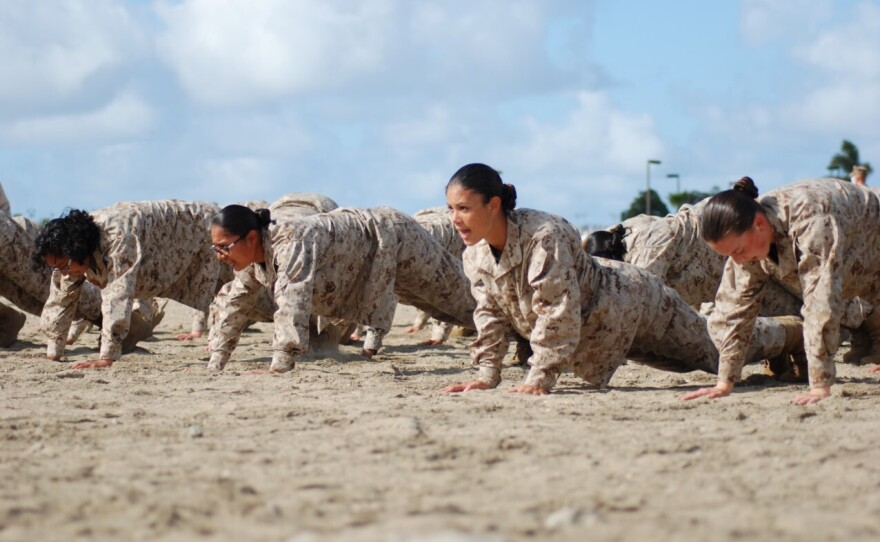
With this being the first female recruiting class at MCRD San Diego, officials are especially sensitive to the issue of sexual assaults. Recent reports from the Department of Defense show that sexual assaults in the military have steadily gone up since 2006 with a 13% jump in 2018 and 3% in 2019. Data for 2020 is not yet available. At MCRD San Diego, an official told KPBS they are “addressing the issue from every angle,” which includes sexual harassment training.

Quarantine
Before boot camp got underway, Marine recruits were quarantined for two weeks due to the coronavirus pandemic. Men and women were housed on separate floors in a hotel at an undisclosed location.
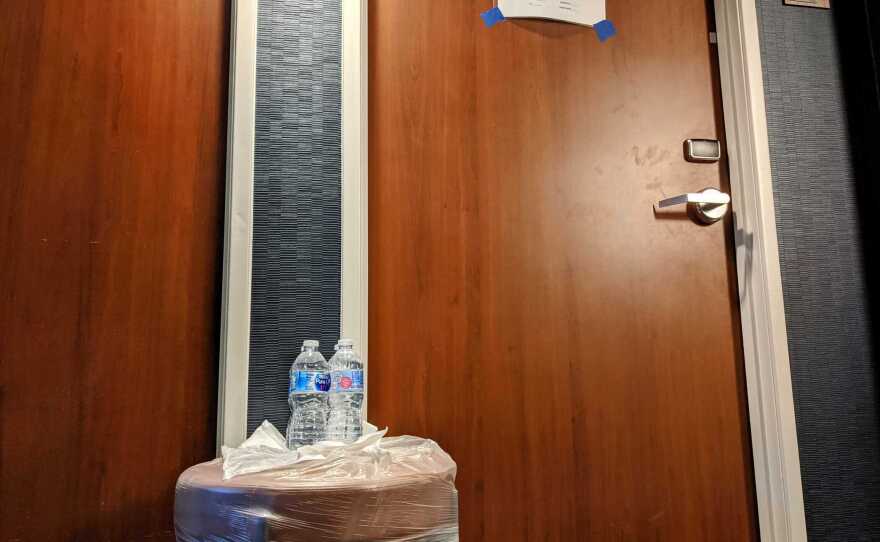
For the duration of the quarantine, recruits were not allowed to leave their rooms. They were only allowed to interact with other recruits for 30 minutes a day at the threshold of their doors. Food and water was delivered and left outside of their rooms.
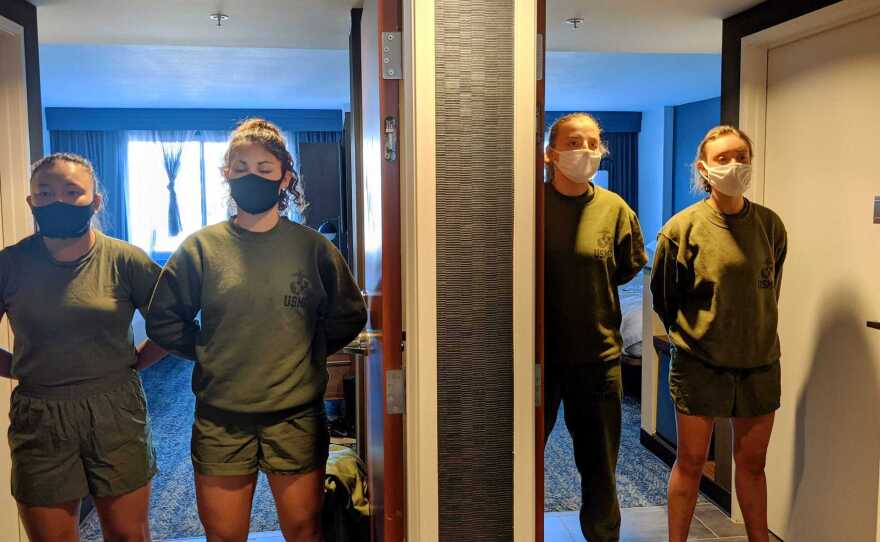
Phones and other electronic devices were taken away. Recruits were allowed only one phone call per week. If they want to get in touch with loved ones, they have to do it the old fashion way — by writing letters.

Despite being under quarantine, recruits kept busy, completing 140 hours of activities. That included having to study because they were quizzed daily on topics ranging from the core values of the Marine Corps to military history.
When their heads weren't in the books, recruits also exercised and meditated.
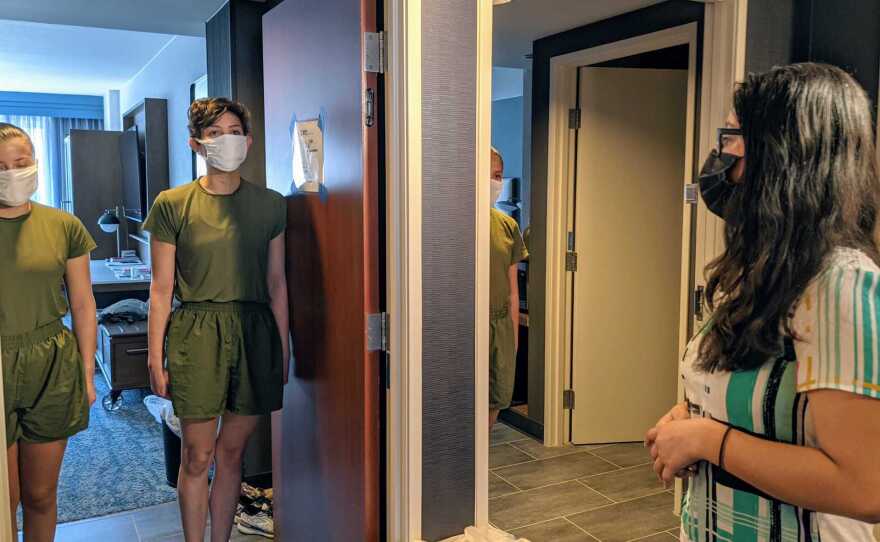
The recruits range in age from high school graduates to college students. Each has their own reason for joining the Marines. For some, it's about seeing the world. For others, it's about family tradition or breaking barriers or simply the challenge of becoming a Marine.
“I'm going to be super proud of myself for overcoming one of the biggest obstacles in my life. I am looking forward to earning the title of the United States Marines, especially being one of the first females to ever be here.” — Marine recruit Gabrielle Ashford, 19, Valparaiso, IN

Yellow footprints
After two weeks in quarantine, recruits started basic training. Once stepping off the bus, their journey from civilian to Marine officially begins.
Commands were shouted, orders were given, and the recruits filed off the bus onto what is famously known to Marines as the "yellow footprints."
In this moment, the women of Lima Company made history.
They are the first female recruits to stand on the yellow footprints at MCRD San Diego.


After entering through the "portal," recruits emptied their bags so drill instructors could check for contraband.
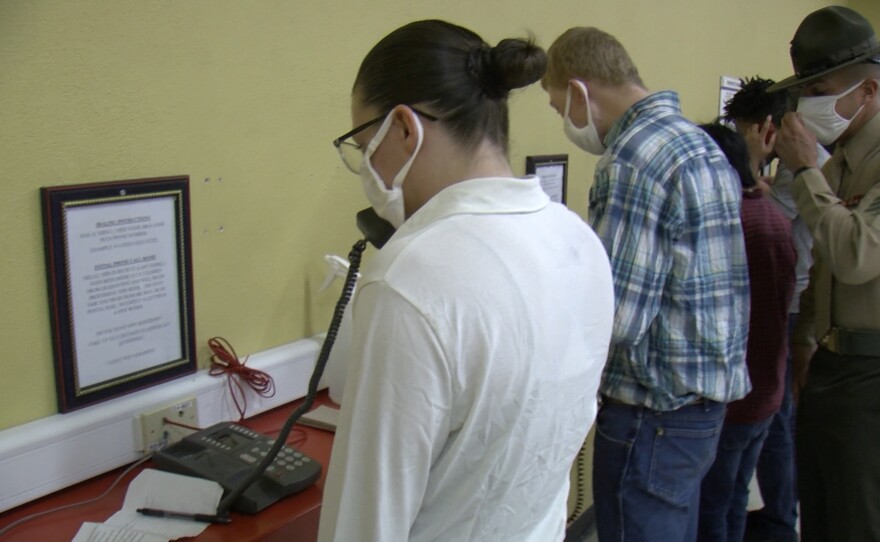
Recruits were given one last chance to call home. Moving forward, they can only correspond by letter.
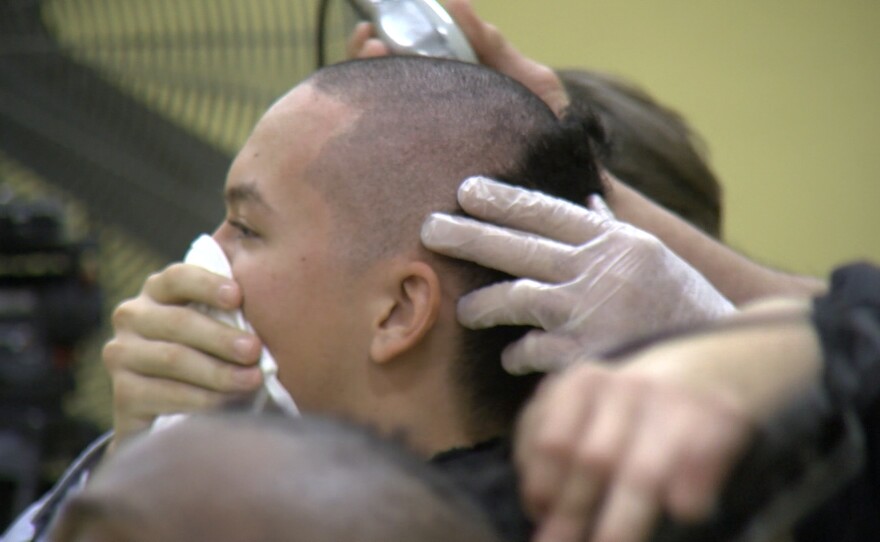
Next, the male recruits got haircuts while female recruits were allowed to keep theirs, just as long as it complied with Marine grooming standards.
Finally, all recruits were issued uniforms for basic training.
“I think it’s a privilege. I wouldn’t trade this for the world. I was originally supposed to go to Parris Island. This is definitely a step up.” — Marine recruit Jhsmyn Banks, 19, Moreno Valley, CA

Confidence course
Four weeks into boot camp, one of the female recruits tested positive for COVID-19, placing the entire female platoon under another two-week quarantine.
However, KPBS was allowed to continue observing their training from a safe distance, but was not allowed to interact with the recruits. MCRD San Diego officials said the COVID-19 exposure did not have a major effect on training.


The Confidence Course is all about one thing: building confidence. Here, recruits learn to overcome self-doubt in a series of challenges that test their mental and physical strength.
That includes:

Hand-to-hand combat training.


Rope climbing.

Navigating obstacles.

And team building.

Water survival training
Marines are amphibious by nature. Naturally, being able to swim is an important skill.
During Combat Water Survival training, recruits are required to swim 25 meters in shallow water, jump from a 15-foot platform to simulate abandoning a ship, swim a short distance and tread water in uniform for four minutes.
Like the obstacle course, recruits once again have to overcome any self-doubt.
Recruits learn how to turn their clothing into a flotation device. After quickly removing their boots, they inflate their pants and blouse, keeping afloat in the event of an emergency at sea.

Bayonet assault course
Thirty-one days into their training at Marine Corps Recruit Depot, San Diego, the men and women of Lima Company are training side-by-side on the Bayonet Assault Course. Here, they are graded on how well they work and communicate as a team.

The recruits start off with a simulated mission briefing where they are given a layout of the course and what needs to be done to complete the mission.

To get the recruits accustomed to the chaos of battle, speakers blare the loud sounds of explosions, machine gun fire and aircraft. The obstacles on the course are designed to simulate the different terrains Marines may encounter in combat.

Recruits crawl through tunnels.

Balance their way across rope bridges.

And crawl beneath barbed wire.

The morning training ended with recruits practicing close-quarters combat using pugil sticks.
Designed to simulate fighting with a bayonet, each end of the stick is padded with a different color — red and black. The red end represents the bayonet.

Rifle range pre-qualification
Six weeks into boot camp, the men and women of Lima Company have moved north from MCRD to Camp Pendleton to continue their training.

This week, they are on the Bravo shooting range, training for their Marine Corps rifle prequalification. For the majority of recruits, this is their first experience with a firearm.
To learn how to become proficient, recruits are paired with a combat marksmanship coach.

In previous weeks, before being allowed on the range, recruits were taught gun safety, to familiarize themselves with their weapon and the four standard Marine shooting positions — standing, kneeling, sitting and prone. On the course, they practice these shots from the 200-, 300- and 500-yard range.

The point of the training is not only to get recruits comfortable with firing their weapons but also to improve their marksmanship. Recruits were each given a notebook to plot where they’re going to shoot, mark where the shot landed and make any necessary adjustments.

Mid-point perspective: Drill instructors
At the mid-way point of training, KPBS sat down with three of the drill instructors of Platoon 3241, the all-female platoon of Lima Company, to get their perspective on how the training is going so far.
The drill instructors say the women of this recruiting class seem to know the microscope they are under and are more motivated and pushing themselves harder.
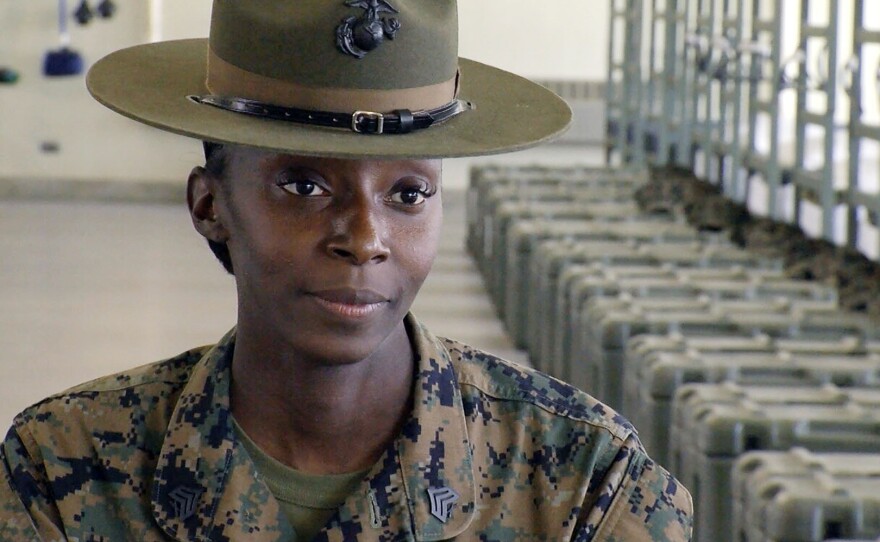
“There is a big difference (between training male and female recruits). The female recruits … they’re quicker on their feet. They understand better. They move faster. They just give so much more and maybe, maybe it’s because this group of young ladies knows that they have something to prove. So they’re going at 1000% at all times.”
— Drill Instructor Sgt. Ikea Kaufman, one of the first female drill instructors to graduate from Drill Instructor Course at MCRD, San Diego.

The 60-strong platoon has since had their numbers reduced by four because of injuries. One recruit was badly injured in a freak accident and another had COVID-19 and was not able to continue.
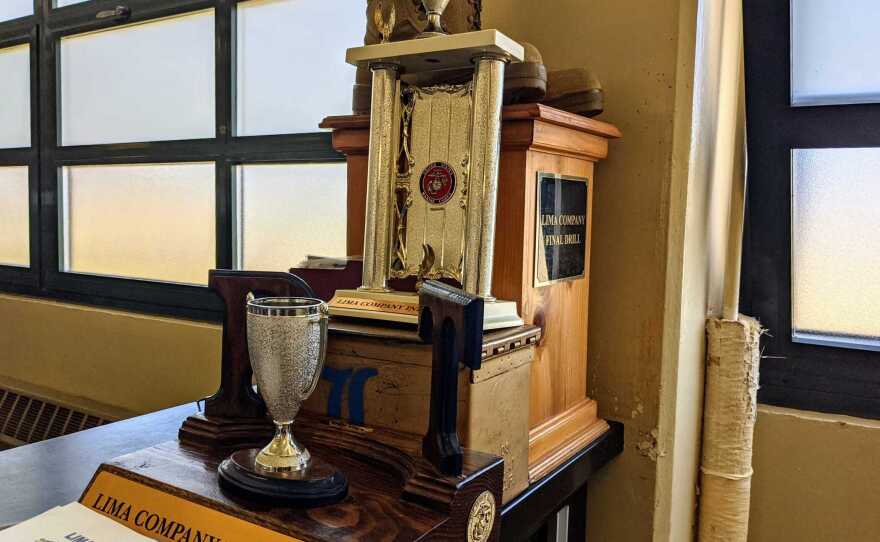
After coming in last during their initial drill, the female platoon has been outperforming their male counterparts, taking first place on the final drill, initial physical fitness test (PFT) and final physical fitness test.

“I think that they’ve been pushed physically harder than I have (when I went through boot camp) because we feel like we have something to prove. And it’s created this higher bar so they don’t feel like they’re meeting this higher bar but in reality, they’re exceeding the bar.”
— Senior drill instructor Staff Sgt. Amber Staroscik, who was brought in from Parris Island to oversee the first group of female recruits in San Diego.

Halfway through boot camp and drill instructors have already seen a difference in the recruits.
“One girl, when she got here … she had a problem with conforming. She wouldn’t move quickly, wouldn’t really sound off for us. She gave attitude and after a while — and I’ve said this to my team — but she’s one of the most improved. Now the way she is, she takes initiative, which is great. She motivates other recruits. She’s always helping other recruits selflessly … she wasn’t doing any of that before.”
— Drill instructor Sgt. Stephanie Fahl, one of the first female drill instructors to graduate from Drill Instructor Course at MCRD, San Diego.

The Crucible
The historic first class of female recruits had one more challenge to overcome before officially becoming a U.S. Marine — the Crucible and its feared Reaper, the highest point in Camp Pendleton.
The Crucible is a three-day, 54-hour grueling hike through the winding hills of Camp Pendleton. It’s the culmination of their 12 weeks of training in boot camp.

Platoon 3241, the all-female platoon of Lima Company, was the first to crest the Reaper. Finishing hurt, hungry and exhausted, they were relieved to not have to climb another hill. Through the ordeal, recruits were allowed only six hours of sleep and two meals.

Of the 60 women who started boot camp, 53 completed the Crucible — about the same attrition rate as the men, Marine spokesman Capt. Martin Harris said. Some of the women who were dropped during the Crucible due to injuries may still graduate as Marines if their drill instructors feel they’ve met all the criteria.

“This is the most exceptional thing I’ve accomplished cuz it’s probably the most important thing. It’s just such a big accomplishment.”
— Pvt. AnneMargret Frazier, 19, a Poway native whose father is also a Marine.

After cresting the Reaper, the newly minted Marines were given an Eagle, Globe and Anchor pin, the emblem of the Marine Corps, signifying they have earned the title Marine.

As a test case for integrated boot camp in San Diego, this was a success, a Marine official said. Drill instructors said they see no reason not to continue integrated boot camps. For now, no other co-ed classes at MCRD San Diego have been announced.
The newly minted Marines will return to MCRD to prepare for their graduation in two weeks.

Graduation
After 13 weeks of basic training, 397 men and women of Lima Company formally graduated from boot camp May 6.
While graduation is a momentous event, this one is a bit more poignant as it is the first class of women Marines to graduate from MCRD San Diego.

With all the attention on them, these women had to prove women can succeed in boot camp with the men. Their drill instructors said they’ve exceeded what was expected of them.

Sixty women started the program, 53 graduated as Marines. This is the same attrition rate as the men.
“As far as training goes, nothing had to be altered for them. And that’s the point that needs to be made.” — Senior drill instructor Staff Sgt. Amber Staroscik.

This is the first time graduates have seen their families since February. During basic training, they could only write letters home.
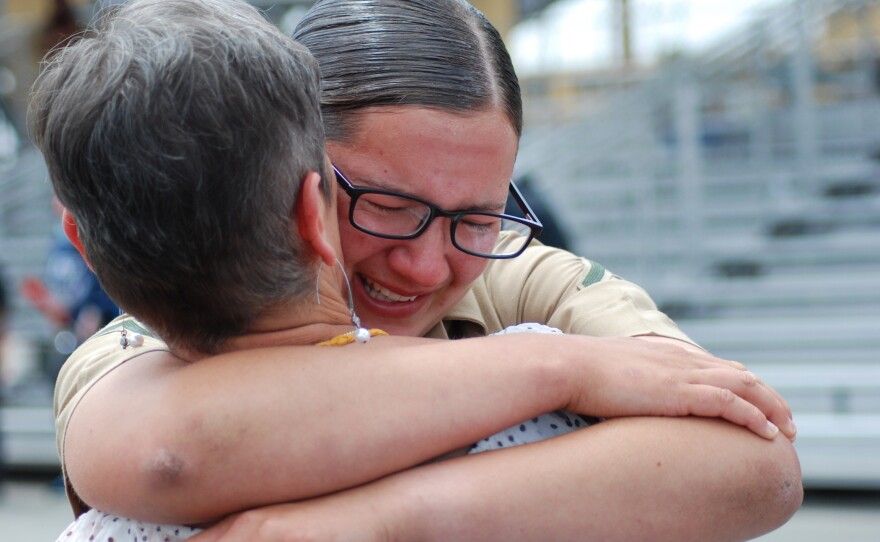
There were tears.

Overwhelming emotions of joy and happiness.
“It was all worth it. I was not expecting to cry this much.”— Pfc. Emily Zamudio
These graduates will now report to the School of Infantry to continue their Marine training.





